Vibrator for concrete - a guarantee of quality styling: the
According to SNiP, high-quality laying of concrete requires mandatory vibration, which provides the necessary density of the mixture and allows you to get rid of the air bubbles involved. To ensure its use of a special construction tool - betonovibrator. We will tell you how such a unit works, what kinds there are, and also show you how to make a vibrator for concrete with your own hands.

Concrete compacting
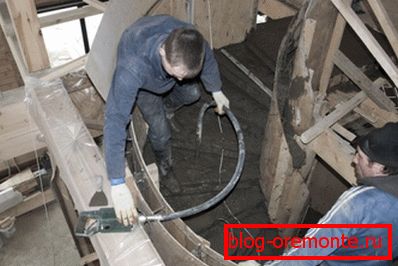
The quality of concreting depends on many parameters, such moments play an especially important role:
- Properly selected recipe and composition of the mixture. From this parameter will depend on the brand of the resulting concrete, as a result - the compressive strength of the material and the ability to withstand the load, as well as its frost resistance, plasticity and other basic indicators;
- High-quality mixing of the components of the mixture. It is also a necessary and very essential condition for normal concreting, since to obtain a durable stone, it is required that the ingredients be as evenly distributed as possible throughout the mixture;
- Proper styling. Monolithic construction involves a certain mode of casting, most often continuous, as well as the mandatory use of vibration.
Note! Vibration is a mechanical effect on a fresh concrete mix using harmonic oscillations transmitted directly or by acting on the formwork or the reinforcement cage.

With the help of vibration exposure it is possible to increase the density of the solution, as well as get rid of air bubbles, which inevitably get involved in concrete during mixing and laying. In addition, the speed of interaction between components increases, the bond of the mixture with reinforcement improves, the strength and quality of the concrete obtained increases.
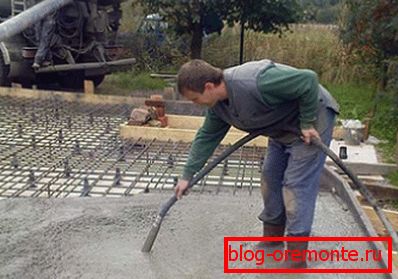
It should also be noted that vibration allows the use of heavy and lean brands of solutions, the plasticity of which is quite low.
Note! By reducing the number of pores and capillaries inside the stone, as well as by increasing the speed and activity of the interaction of the components and the hydration of the cement, the frost resistance and moisture resistance of the material obtained increases. In addition, due to vibration, the mixture fills the entire volume of formwork much more closely and quickly, which is also important for high-quality concrete placement.
Device and types of vibrators
Principle of action
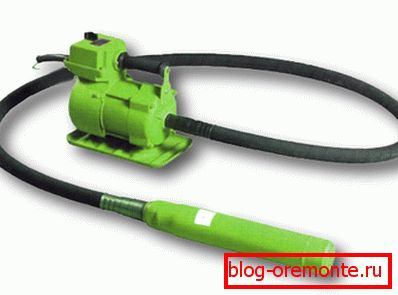
All types of vibrotools for concrete work on the same principle: the rotational energy is converted into vibrational energy, which affects the mixture. To implement this transformation, an eccentric shaft is used, the center of gravity of which is shifted relative to the axis of rotation.
Such a shift leads to a centrifugal force, which acts along the line of the radius of rotation from the center to the outer edge of the circle.
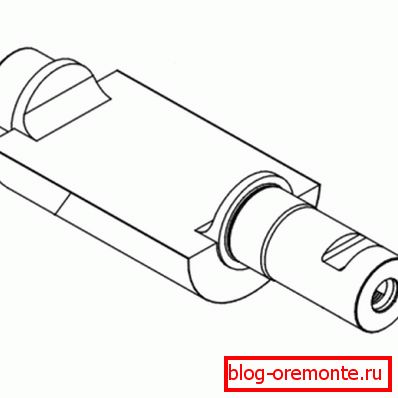
Since the unbalance element constantly rotates, the direction of the arising force is constantly changing, and any applied force (if it is sufficient) causes movement. But since the direction of the force is variable, instead of directional motion, an oscillation occurs, the frequency of which is equal to the frequency of rotation of the shaft with the eccentric.
Roughly speaking, such a design constantly seeks to leave the initial position, but, having shifted a millimeter in one direction, immediately begins to move in another, and then in the opposite direction.

In order to ensure the rotation of the shaft, using different types of engines. These can be electric motors, internal combustion engines or pneumatic drives. The most commonly used electric motors powered by 220 volts.
The process of transferring the vibration effect of the mixture depends on the type and design of the instrument, as well as on the nuances of installation. Next, we consider the main types of concreters, among which there are such main types:
| Device type | Purpose |
| Deep | Used for various types of work, we can say that it is the most versatile device for the vibration treatment of concrete |
| Surface | It is used for laying plates and screeds, as well as blind area, paths and platforms |
| Outer | Used in the construction of thin-walled structures, columns, pillars and other structures with frequent reinforcement |
Note! The design of the vibrator for concrete depends on the type of construction, and the method of transmitting vibrations to the solution and the method of transmitting the rotation to the vibrating shaft from the motor shaft primarily differ.
Deep

First of all, we want to consider the most versatile and common type of instrument - deep or submersible vibrators.
They are of two types:
- Electromechanical with a motor with a frequency of 50 Hz and a flexible shaft of transmission of rotation;
- High-frequency with submersible motor located in the tip.
The first type is a device consisting of three main nodes:
- Electric asynchronous motor with a frequency of 50 Hz. The engine is located on the surface and outside the formwork or concreting zone. As a rule, units of 0.5 - 2.5 kW are used;
- Flexible shaft, which consists of a steel cable and plastic flexible sheath. Also, the device has a mechanism for fastening the cable to the motor shaft at one end, to the shaft of the vibrator - at the other;
- Vibrating tip or mace, which is a steel cylinder, in which a planetary vibration mechanism is installed on bearings and couplings.

Such a tool, as a rule, is portable, except for the cases when large-scale concreting is performed and the packages of vibrators are suspended on a frame moved by cranes. The disadvantages of this device include a sufficiently large weight of the engine and a low frequency of vibration, since the speed of rotation of the shaft is limited.

It should also be borne in mind that the flexible shaft requires care and lubrication, and the tip is subject to serious impacts, which, if improperly maintained, quickly wear the device. The advantage is the relatively low price of the tool.
High-frequency units are the most convenient and high-quality, however, and more expensive. Here the high-frequency motor - 200 Hz - is located directly in the mace, which is immersed in a solution on a special extension cord. The high frequency of vibration (about 10 - 12 kHz) provides better compaction of concrete.

The engine is powered by 36 V and is connected to the network through a transformer and a frequency converter. There are also high-frequency vibrators for 220V concrete, in which a frequency converter and a transformer are embedded.
Note! Submersible vibrators are the most convenient and versatile tool that is suitable for most concrete work, such as the construction of foundations, armored belts, grillages, slabs, walls and columns with medium frequency reinforcement.
Surface
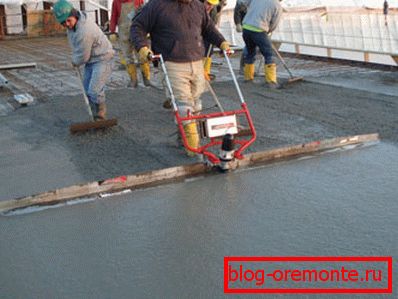
Surface vibrators are often called vibrating rails, as they are an engine with an eccentric, the body of which conveys vibration to the rule, with which they level the solution when laying the screed. Rule or rail usually move along the lighthouses, however, independent movement is also possible.
This device is suitable for the construction of shallow screeds, plates, platforms, paths, steps, etc. Also, there are surface vibration installations, where a metal platform is used instead of a lath. Their appointment is the same.

Note! Such a tool has a fairly narrow scope and for the construction of large-scale objects, foundations, columns, grillages and belts is not suitable.
Outdoor
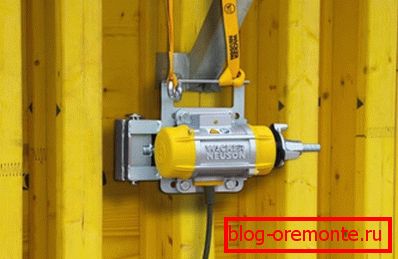
Also widely used outdoor vibration installation. They are the simplest: an engine with unbalance is attached to the formwork and transmits vibration to the solution through it.
Such devices have shown themselves well in monolithic construction of walls, columns, and armopoyas, however, they are not suitable for slabs, screeds and massive foundations. The product must have a maximum area of contact with the formwork and be sufficiently thin-walled.

The engines used here are mainly high-frequency (it is also typical for surface devices), which allows laying the concrete in the most qualitative way and getting a strong product with high-quality geometry.
Note! When building columns, walls and grillages with frequent reinforcement, there is often no alternative to external vibrators at all, since the depth devices simply will not pass through the rebar.
Making a vibrator at home
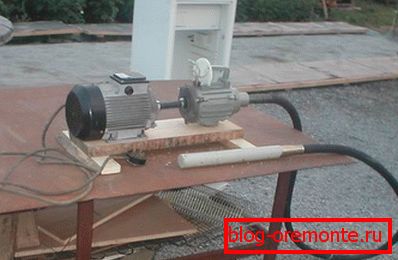
If you do not want to buy or take a concrete vibrator for rent, then our instruction will help you to build it yourself:
- The mace is made of a steel cylinder with a diameter of 40 mm, in which a steel rod is placed on the bearings, to which a shorter piece of steel rod of square section is welded to the side. One end of the cylinder is closed with a lid on the thread or brewed, and from the second one the shaft is taken out and a through transverse hole is made on it for fastening with a pin;

- A flexible shaft is made of a reinforced rubber hose, inside of which is placed a steel cable from a car or a cable to clean sewers. At the ends of the cable weld the segments of the rod, which it will be attached to the motor shaft and the shaft tip;

- As a motor, it is best to use a powerful grinder, since the frequency of its rotation is maximum. Also suitable powerful drill.

- It is better to close the joints with rubber tubes and clamps from dust and mortar, especially for mace bearings. It is obligatory to cover the mace with a plastic or rubber casing in order to avoid corrosion from contact with concrete.

Note! Take care that no water, solution or dust get into the bearings, otherwise they may jam and damage the engine.
Conclusion
For various concrete work necessarily use a deep, external or surface vibrator for concrete.
The video in this article will help you understand how the styling is done with vibration.